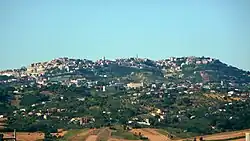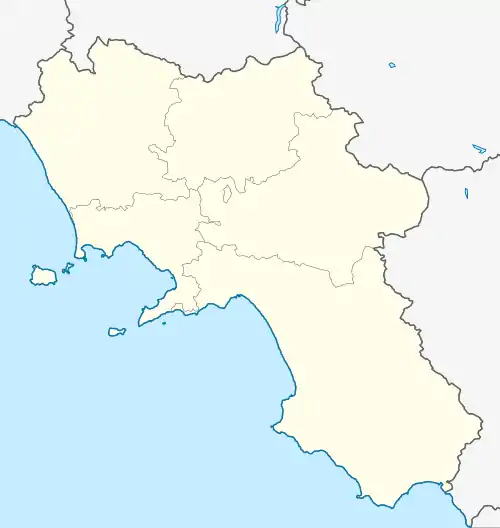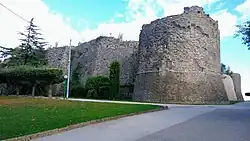Ariano Irpino
Ariano Irpino (formerly Ariano di Puglia or simply Ariano) is an Italian city and municipality in the province of Avellino, in the Campania region. With a territory of 186.74 square kilometres (72.10 sq mi) and a population of 22,535 (2017),[3] it is one of the largest settlements in the Irpinia historical district and the modern province. Located 264 kilometres (164 mi) east-southeast of Rome and 104 kilometres (65 mi) east-northeast of Naples, the comune was granted the official status of Città ("City") by a presidential decree of 1952, October 26;[4] it has been recognized as an arts town, too.[5]
Ariano Irpino
Ariano di Puglia (until 1930) Ariano (attested since 797) | |
|---|---|
| Città di Ariano Irpino | |
 Panorama of Ariano Irpino | |
 Coat of arms | |
 Ariano Irpino within the Province of Avellino | |
Location of Ariano Irpino | |
 Ariano Irpino Location of Ariano Irpino in Italy  Ariano Irpino Ariano Irpino (Campania) | |
| Coordinates: 41°9′10″N 15°5′20″E | |
| Country | Italy |
| Region | Campania |
| Province | Avellino (AV) |
| Government | |
| • Mayor | Enrico Franza (PSI) |
| Area | |
| • Total | 186.74 km2 (72.10 sq mi) |
| Elevation | 788 m (2,585 ft) |
| Highest elevation | 811 m (2,661 ft) |
| Lowest elevation | 179 m (587 ft) |
| Population (30 April 2017)[3] | |
| • Total | 22,535 |
| • Density | 120/km2 (310/sq mi) |
| Demonym | Arianese |
| Time zone | UTC+1 (CET) |
| • Summer (DST) | UTC+2 (CEST) |
| Postal code | 83031 |
| Dialing code | 0825 |
| ISTAT code | 064005 |
| Patron saint | Otho Frangipane |
| Saint day | 23 March |
| Website | Official website |
Geography

Overview
At an elevation of 788 metres (2,585 ft) above sea level, Ariano Irpino is centered between the Adriatic Sea and the Tyrrhenian Sea. It is 39 km east of Benevento, 51 km north-east of Avellino and 62 km south-west of Foggia.
Formerly called just Ariano, it was built on three hills, and for that reason it is also known as Città del Tricolle ("City of the Three Knolls"). From the Norman era, but formally only since 1868 to 1930, it was known as Ariano di Puglia. Irpinia is the name given to the area of the Apennine Mountains between Campania and Apulia; the name stems from the Oscan word hirpus, meaning wolf.
Ariano lies in the centre of a fertile but rugged district and has only a few buildings of historical importance, as it was devastated by earthquakes in 988, 1456 and 1732.[6]

Towering over the surrounding countryside, the town was a military position of some importance in the Middle Ages,[6] and it still has a Catholic diocese and retains many public offices and utilities which serve all surrounding smaller towns too. However, many inhabitants reside in farms and still live on agriculture or craftsmanship.
Ariano Irpino experiences a warm-summer Mediterranean climate (Csb/Cfb in the Köppen climate classification), with moderate rain, occasional snow and quite rare hail.
Surroundings
The municipality borders Apice (BN), Castelfranco in Miscano (BN), Flumeri, Greci, Grottaminarda, Melito Irpino, Montecalvo Irpino, Monteleone di Puglia (FG), Savignano Irpino, Villanova del Battista and Zungoli.[7]
History
The town is of ancient origin; archaeological evidence points to its continuous settlement from the Neolithic (c. 7th millennium BC) to around 900 BC at La Starza rock site. The foundation of the Roman vicus of Aequum Tuticum, not far from La Starza, was formerly credited to the Hirpini Samnites, although there is no evidence of this (except for the Samnitic Oscan word Tuticum, meaning "public"); in any case, it was only within the Roman Empire that the vicus became the crossroads of the Via Traiana and Via Herculia and Via Aemilia highways. However, soon later Aequum Tuticum dramatically declined following the onset of the barbarian invasions.

As a result of this, the three hills started to be inhabited, a high and easily defendable place, and it is here that Ariano proper was born, a fortified city in a strategic position; however its ancient and formidable defensive walls are hardly recognizable today. In a secure place away from the invasions of the Goths and Byzantines, Ariano is a fortified town of the Lombards. Around 800 the Castle of Ariano was built to defend the city against the Byzantines which, although ruined, still proudly stands in the panoramic Villa comunale city park.
Successively conquered by the Normans, in 1140 it was the place where the king Roger II of Sicily promulgated the Assizes of Ariano, the then-new constitution of the Kingdom of Sicily. This legal corpus would be adopted almost complete and with a few variations into the Constitutions of Melfi of the Emperor Frederick II. In the same venue Roger II minted the ducat, a coin that would last for seven centuries, until 1860.
In 1255, Manfred, son of Frederick II, besieged the city, which resisted strongly thanks to its walls and the combative nature of its inhabitants. During the siege, a group of soldiers from Lucera pretended to be deserters from Manfred's army, and were welcomed into the town. During the night, they revealed their identity, sacking and destroying the city with fire, and killing or deporting many inhabitants. There is still a road marking the event, called La Carnale (The Carnage).
More than ten years later, in 1266, Charles I of Anjou rebuilt the city and gave it two thorns of the crown of Christ, still conserved in a reliquary within the Museum of silverware, beside the town's Romanesque cathedral. All these events are commemorated every year (in August) in the Rievocazione Storica del Dono delle Sante Spine (Historical Reinvocation of the Gift of the Sacred Thorns) and the reproduction of the Incendio del Campanile (Belltower Burning), a pyrotechnic event that lights the main square of the city and the side of the cathedral.
After the Capetian House of Anjou lost control of Sicily to Peter III of Aragon in the War of the Sicilian Vespers, the city passed to the Provençal family of Sabran from 1294 to 1413; and then into the hands of the Carafa family and the House of Gonzaga. Today are there still in the town buildings that belonged to the Spanish families that governed at the time. On 2 August 1545 the city rebelled against the feudal regime and became a Città Regia (city-state) dependent on the Viceroy of the Kingdom of Sicily.
Culture
Majolica

Ariano is known for the production of majolica, a tin-glazed pottery.[8] The first examples date from the 13th century under the Moorish influence of the Spanish, but Ariano Irpino ceramics became more refined around the 18th century, when the first amphorae and pitchers appear, often simple in the shape, but thinly elaborated. Today's production is even large, including flask, busts, cups, plates, figures, and amphorae. All pieces are splendidly decorated by the craftsmen of Ariano, and often have a fine and elaborate shape.
Museums

Today the town houses some museums:
- the City Museum and Ceramics Gallery
- the Archaeological Antiquarium, which displays artifacts from La Starza and Aequum Tuticum
- the Museum of Norman Civilization, with a numismatic section and a chamber of Medieval polearms
- the Catholic Diocesan Museum, with works of art from the diocese of Ariano-Lacedonia
- the Museum of Silverware, in the Cathedral, which displays two sacred thorns of the crown of Christ gifted to the town by King Charles I of Anjou in 1269
- the Museum "Giuseppina Arcucci", at the Sister's of Holy Spirit's.[9]
Research activity
In the town are located CESN (the European Centre of Norman Studies) and BioGeM (Biology and Molecular Genetics in the Mezzogiorno).
Food
Ariano Irpino's country-people produce food from traditional agriculture. Many shops and restaurants offer produce as bread, pasta, pizza, meat, cherries, Irpinia olive oil and Caciocchiato, a typical cheese.
Dialect
Ariano Irpino is home to the Arianese dialect, a variety of the Irpinian dialect.
Health

Saint Ottone Frangipane Hospital was built in 1972 as a utility for the Campanian health district No. 1, that includes 29 municipalities with a total population of 87,993.[10] Actually an ancient Hospitalis pro Peregrinis et Infirmis, along with a pavilion for lepers, was founded thereabout in 1410, but it was relocated in 1731 in the neighboring St. Jacob Palace, where today is the Ceramics Museum's scientific and educational center.
In the north-eastern outskirts of the town there is also the headquarters of MIR (Medicinal Investigational Research), a department of BioGeM University Consortium that is involved in medical and pharmaceutical research.
Transport

The SS90 national road connects the town to A16 (Naples-Bari motorway) Grottaminarda junction and A14 (Bologna-Taranto highway) Foggia junction.
From Ariano Irpino railway station (located 6 km away from the town centre), daily trains reach Rome in 3h30, and Bari in 2 hours. The nearest airport is Naples-Capodichino airport, linked to Ariano Irpino by Air busses; these also reach the towns of Avellino, Benevento and Foggia.
People
_(14777069002).jpg.webp)
- Ottone Frangipane (1040-1127), saint
- Saint Elzéar of Sabran (1285-1323), Count of Ariano
- Hieronymus Angerianus (1470-1535), humanist
- Diomede Carafa (1492-1560), bishop and cardinal
- Pietro Paolo Parzanese (1809-1852), poet
- Ortensio Zecchino (b. 1943), academic and politician
- Luca Morelli (b. 1987), motorcycle racer
See also
References
- "Superficie di Comuni Province e Regioni italiane al 9 ottobre 2011". Italian National Institute of Statistics. Retrieved 16 March 2019.
- "Ariano Irpino". Comuni Italiani (in Italian).
- (in Italian) Source: Istat 2011
- Archivio Centrale dello Stato (ed.). "Ufficio araldico - Fascicoli comunali" [Heraldic Office - Municipal dossiers] (in Italian). Archived from the original on 2016-04-19. Retrieved 2019-02-09.
- "Musei" [Museums] (PDF). Corriere del Mezzogiorno. Archived (PDF) from the original on 2022-12-24.
- One or more of the preceding sentences incorporates text from a publication now in the public domain: Chisholm, Hugh, ed. (1911). "Ariano di Puglia". Encyclopædia Britannica. Vol. 2 (11th ed.). Cambridge University Press. p. 490.
- 41091 Ariano Irpino on OpenStreetMap
- (in Italian) The "Maiolica Arianese"
- Ariano Irpino on Visit Italy
- Regione Campania. "Piano Regionale di Programmazione della Rete per l'Assistenza Territoriale 2016-2018" [Regional Plan Program for the Network of Territorial Assistance] (PDF). Quotidiano Sanità (in Italian). p. 17.
External links
- Official website (in Italian)
- Città di Ariano (in Italian)
